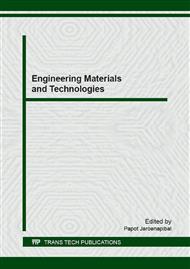p.143
p.148
p.157
p.163
p.169
p.177
p.184
p.191
p.196
Utilization of Kelut’s Volcanic Ash as the Aggregate Mixture of Concrete Brick
Abstract:
Kelut volcano had erupted in February 2014. The eruption has produced various materials i.e. ash, sands, etc. Volcanic ash contains various elements such as Si, Al, Ca, Fe, Na and P. It is potential to be used as raw material for cement-based products. This study investigates the utilization of Kelut’s volcanic ash as the raw material of cement-brick. The Kelut’s volcanic ash was analyzed to determine the contents of iron (Fe), aluminum (Al), and silica (Si). The volcanic ash was screened to obtain 100 mesh size of ash. The volcanic ash of 100 mesh size was mixed with cement, sand, and water with ratio of 1 kg cement, 2 kg volcanic ash, and 15 kg sand (1 :2 :15). The mixture of volcanic ash, sand and cement was poured and pressed in the concrete brick mold. The concrete brick was then aerated in a room for hardening process. The experiment was repeated for another ratio of raw material (cement: volcanic ash: sand = 2:1:15) and the age of the concrete brick (46, 61, 75 and 89 days). Concrete bricks were analyzed to determine the quality and the mechanical characteristics. The results has shown that Kelut’s volcanic ash has a composition of aluminum (Al) 4.707%, silica (SiO2) 23.4%, and iron (Fe) 3.85%, that is like the composition of the cement materials. The concrete bricks which are made of cement, Kelut’s volcanic ash, and sand with the ratio of 2:1:15 has a maximum compression strength of 18.85 MPa at the age of 89 days. The addition of Kelut’s volcanic ash has improved the strength of concrete brick. However, too much volcanic ash will lead to increasing compression strength.
Info:
Periodical:
Pages:
196-200
Citation:
Online since:
November 2016
Authors:
Price:
Сopyright:
© 2017 Trans Tech Publications Ltd. All Rights Reserved
Share:
Citation:


